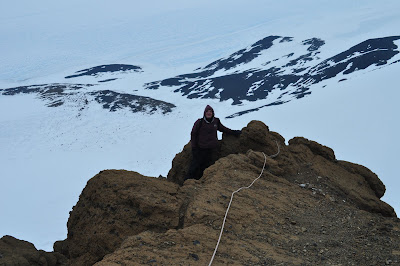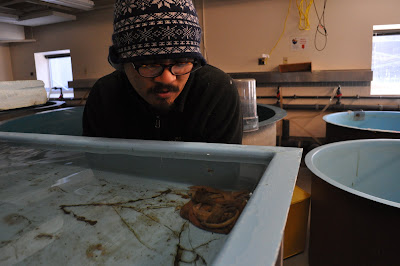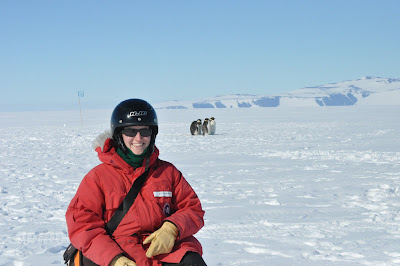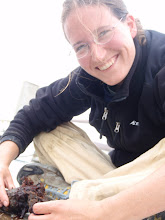
Today I got to sleep in (!!!!!!!!) and then went out to Pegasus again. Deneb, the prof for the phytoplankton group, wanted to collect one more plankton sample and invited anyone who wanted to come along. So we ended up with 11 of us and loaded onto the snowmobiles.


We had another great view of Erebus on the way out. The weather here is so weird, half the time Erebus is clear and half the time you would never know it was there. On the way out there were really cool clouds forming a layer around the mountain and on the way back we couldn't see it at all.
We have to bring survival bags everywhere we
 go, so on the snowmobiles we have big sleds to tow them and any other gear we have. On the way out, Dennis rode on top of the sled, and then I rode on it on the way back, at least until it hit a rut and flipped. Unfortunately no one got a picture, but I heard it was a spectacular wipe-out. Don't worry, Mom, I'm fine.
go, so on the snowmobiles we have big sleds to tow them and any other gear we have. On the way out, Dennis rode on top of the sled, and then I rode on it on the way back, at least until it hit a rut and flipped. Unfortunately no one got a picture, but I heard it was a spectacular wipe-out. Don't worry, Mom, I'm fine.There were
 seals coming up to breathe at both holes pretty regularly. In fact, we didn't have to shovel the ice off the holes when we got there because the seals kept them open. Apparently they bite at the edges of the ice to keep the hole open. I know that they're charismatic megafauna and not nearly as cool as invertebrates, but they do kind of remind me of my dog, which is somewhat endearing.
seals coming up to breathe at both holes pretty regularly. In fact, we didn't have to shovel the ice off the holes when we got there because the seals kept them open. Apparently they bite at the edges of the ice to keep the hole open. I know that they're charismatic megafauna and not nearly as cool as invertebrates, but they do kind of remind me of my dog, which is somewhat endearing.Nishad, who is from Sri Lanka, brought a cricket bat and ball out with us and we all played cricket wh
 ile Deneb collected her sample. They set up a wicket with ice axes and a big stick. Apparently in real cricket, the ball is supposed to bounce, which is somewhat challenging in cricket-on-the-ice, as footprints make the ball stop or bounce in random directions. Nishad was complaining about the pitch, but I think it made the game more entertaining.
ile Deneb collected her sample. They set up a wicket with ice axes and a big stick. Apparently in real cricket, the ball is supposed to bounce, which is somewhat challenging in cricket-on-the-ice, as footprints make the ball stop or bounce in random directions. Nishad was complaining about the pitch, but I think it made the game more entertaining. I think in general, cricket is not intended to be a full-contact sport, but trying to run in heavy bunny boots adds an extra element of challenge. We also learned that rubber balls in cold weather is not a good combination. The ball split, but at least it didn't end up in the seal hole.
Tomorrow I have to pack and clean. We have room inspections at 4 tomorrow... they don't let you on the plane if your room isn't clean.












































